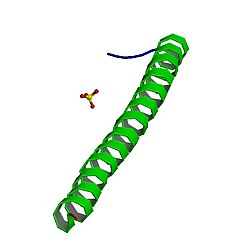Adenomatous polyposis coli (APC) also known as deleted in polyposis 2.5 (DP2.5) is a protein that in humans is encoded by the APC gene.[4] The APC protein is a negative regulator that controls beta-catenin concentrations and interacts with E-cadherin, which are involved in cell adhesion. Mutations in the APC gene may result in colorectal cancer and desmoid tumors.[5][6]
APC is classified as a tumor suppressor gene. Tumor suppressor genes prevent the uncontrolled growth of cells that may result in cancerous tumors. The protein made by the APC gene plays a critical role in several cellular processes that determine whether a cell may develop into a tumor. The APC protein helps control how often a cell divides, how it attaches to other cells within a tissue, how the cell polarizes and the morphogenesis of the 3D structures,[7] or whether a cell moves within or away from tissue. This protein also helps ensure that the chromosome number in cells produced through cell division is correct. The APC protein accomplishes these tasks mainly through association with other proteins, especially those that are involved in cell attachment and signaling. The activity of one protein in particular, beta-catenin, is controlled by the APC protein (see: Wnt signaling pathway). Regulation of beta-catenin prevents genes that stimulate cell division from being turned on too often and prevents cell overgrowth.
The human APC gene is located on the long (q) arm of chromosome 5 in band q22.2 (5q22.2). The APC gene has been shown to contain an internal ribosome entry site. APC orthologs[8] have also been identified in all mammals for which complete genome data are available.
- ^ a b c GRCm38: Ensembl release 89: ENSMUSG00000005871 – Ensembl, May 2017
- ^ "Human PubMed Reference:". National Center for Biotechnology Information, U.S. National Library of Medicine.
- ^ "Mouse PubMed Reference:". National Center for Biotechnology Information, U.S. National Library of Medicine.
- ^ Nishisho I, Nakamura Y, Miyoshi Y, Miki Y, Ando H, Horii A, et al. (August 1991). "Mutations of chromosome 5q21 genes in FAP and colorectal cancer patients". Science. 253 (5020): 665–669. Bibcode:1991Sci...253..665N. doi:10.1126/science.1651563. PMID 1651563.
- ^ Markowitz SD, Bertagnolli MM (December 2009). "Molecular origins of cancer: Molecular basis of colorectal cancer". The New England Journal of Medicine. 361 (25): 2449–2460. doi:10.1056/NEJMra0804588. PMC 2843693. PMID 20018966.
- ^ Cite error: The named reference
:1was invoked but never defined (see the help page). - ^ Lesko AC, Goss KH, Yang FF, Schwertner A, Hulur I, Onel K, Prosperi JR (March 2015). "The APC tumor suppressor is required for epithelial cell polarization and three-dimensional morphogenesis". Biochimica et Biophysica Acta (BBA) - Molecular Cell Research. 1853 (3): 711–723. doi:10.1016/j.bbamcr.2014.12.036. PMC 4327896. PMID 25578398.
- ^ "OrthoMaM phylogenetic marker: APC coding sequence".[permanent dead link]



